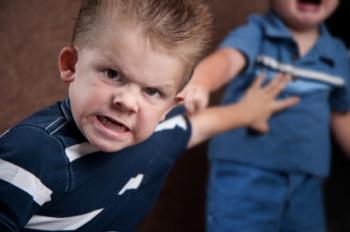The words "conduct disorder DSM 5" relate to the allocated criteria for the diagnosis of conduct disorder in the fifth edition of the journal titled, "Diagnostic and Statistical Manual of Mental Disorders". As per statistical data, 2%-16% of children in the U.S. have been diagnosed with conduct disorder, of which a majority of the population are boys in their early teen years. Conduct disorder is a cumulative term for several disruptive behavioral disorders. There is a huge risk of developing psychological disorders involving drug overdose, substance abuse, personality disorders and mental weakness if conduct disorder isn't treated in its early days.
Conduct Disorder (DSM 5) Symptoms
You will notice a consistent and stubborn behavioral pattern and there will be a violation of basic societal norms and manners. With time, the following symptoms of conduct disorder (DSM 5) could develop:
1. Aggression
 Bullying, intimidating and threatening others, like inferior kind
Bullying, intimidating and threatening others, like inferior kind- Physical aggression in fights
- Using weapons, like a knife, bat or even gun, to harm others physically
- Cruelty towards people and animals
- Mugging, armed robbery, or stealing from a victim
- Sexual abuse
2. Destructive Tendencies
- Doing things like setting fire with the sole intention of causing serious damage
- Deliberately harming others' stuff and creating chaos
3. A Consistent Feeling of Deceitfulness
- Breaking into places, like car, house or building, with the intention of stealing property
- Constantly lying for their own benefits or to avoid taking responsibilities
- Stealing high-valued stuff without being caught by the owner, such like stealing property, forgery and shoplifting
4. Seriously Violating Rules
- Disobeying parents and disrespecting their prohibitions usually in their late childhood years, smaller than 13 years old.
- Running away from home overnight twice (at least) while living with their parents, or not returning for a relatively long period of time once.
- Absconding from school without any permission, which happens before 13 years old
Remember there should be at least 3 of the abovementioned conduct disorder (DSM 5) symptoms in the past 12 months and there should be at least one symptom that lasts for the past 6 months.
Types of Conduct Disorder
Here are 2 types of conduct disorder (DSM 5): childhood-onset conduct disorder and adolescent-onset conduct disorder. Now let's take a close look at them.
The Childhood-Onset Conduct Disorder
If any of the aforementioned symptoms is seen on a 10-year-old child, then the child could be diagnosed for childhood-onset conduct disorder. This conduct disorder is mostly seen in male individuals and is marked by a consistent display of physical aggression toward others which leads to imbalanced peer relationships. In the early stages, it is referred to as oppositional defiant disorder which by the time of puberty could mature into conduct disorder. These individuals are more prone to psychological conditions like antisocial personality disorder when compared to the adolescent-onset type.
The Adolescent-Onset Conduct Disorder
In this type, the symptoms are seen after the age of 10 years approximately around the beginning of the adolescent years. At this age, there are very limited cases of children displaying aggression and getting into physical fights. The type of conduct disorder is much mild and children tend to have much normal peer relationships. Even though male individuals are more prominent, the number of girls is higher than the average count.
Causes of Conduct Disorder
Although the exact cause of conduct disorder (DSM 5) is not known, the following five factors listed below can trigger this condition:
- Biological: Dealing with the physiological aspects, this theory believes that any injuries to parts of the brain could lead to behavioral disorders. Conduct disorder is due to a hotspot in certain brain regions which are responsible for behavioral regulation, impulse and emotional control. Besides, even preset mental illnesses, like the attention-deficit/hyperactivity disorder (ADHD), drug abuse or depression, can contribute to the maturation of conduct disorder.
- Genetics: There have been many cases where children diagnosed with conduct disorder have family histories of mental illnesses, anxiety disorders and personality disorders. Partial inheritance is possible which could make them vulnerable to conduct disorder.
- Environment: External environmental factors like an improper family life, abuse and traumatic experiences during childhood, all contribute to developing conduct disorder.
- Psychological factors: Few doctors have correlated conduct disorder with various psychological disorders and inefficient mental capabilities.
- Social: Most often, competitors are the harshest risk factors for developing conduct disorder.
Dealing With Conduct Disorder
The treatments of conduct disorder (DSM 5) rely mainly on factors like child's age, the symptoms and more importantly the child's ability of coping with changes and participating in therapy sessions. There are 2 treatment methods - therapy and medication.
Psychotherapy
- Counseling, one type of psychotherapy, assists children in the whole treatment process to learn how to control and express anger in an acceptable manner without harming anyone.
- Children are also subjected to cognitive-behavioral therapy which tries to model the children's cognitive abilities so as to enhance the basic skills required in life, like problem solving, aggression control, moral skills and impulse control.
- There is also family therapy which encourages children to interact more with their family members. For completing these sessions, parents have to go through a pre-requisite course of parent management training (PMT) which will help parents monitor and correct their children's behaviors at home.
Medication
Although there are little medicines specializing in treating conduct disorder (DSM 5), there are various drugs used for the symptoms as well as other secondary psychological disorders which are associated to it.
